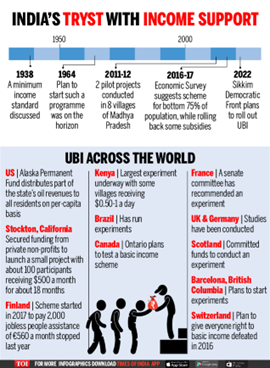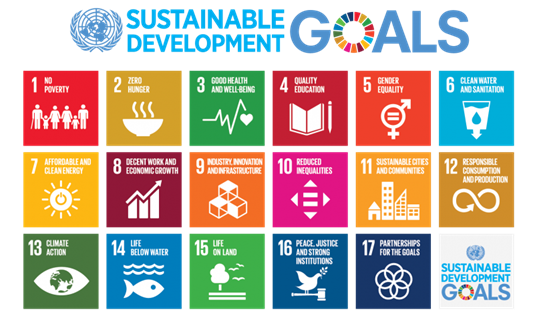Contents :
- A modified UBI policy may be more feasible.
- India’s SDG focus and its human development issues
A Modified UBI Policy May Be More Feasible.
Context: The International Labour Organisation’s observation of lagging job growth due to the rise in automation and artificial intelligence, jobless growth, and unemployment in India has sparked widespread debate about implementing universal basic income as a safety net.
Example 1: World Economic Forum’s Future of Jobs Report 2023 projects 83 million job losses due to AI and another economic driver over the next five years.
Example 2: In June 2024, the unemployment rate in India rose to 9.2%, according to data from the Centre for Monitoring Indian Economy (CMIE).
Relevance: GS2 ( Social justice ), GS3 ( Indian Economy ).
Practice question: Discuss how universal basic income can act as an efficient social net. Explain its advantages and disadvantages highlighting implementational challenges. (250 words ).

History :
- The earliest mention is traced back to 16th-century philosopher Thomas More’s work Utopia(1516), where he describes guaranteed income for everyone in the society.
- Madhya Pradesh Pilot: Conducted by the Self-Employed Women’s Association (SEWA) in 2011-2012, this pilot provided Rs 200 per month to each adult in selected villages.
- 2016-17: The Economic Survey mentions UBI as a potential policy, and advocates UBI as an alternative tool to various welfare schemes to address poverty in India.
Debate of feasibility and desirability :
Pro-Feasibility Arguments:
- JAM Infrastructure: The Jan-Dhan, Aadhaar, and Mobile (JAM) infrastructure is already established, which can facilitate the direct transfer of UBI benefits efficiently.
- Pilot Programs: Experiments like SEWA’s pilot in Madhya Pradesh have demonstrated positive outcomes in poverty reduction, suggesting UBI’s potential for scalability.
Anti-Feasibility Arguments:
- High Fiscal Cost: may require 3.5% to 11% of GDP annually which is higher than annual spending on public health.
- Infrastructure Gaps: Digital connectivity, especially in rural areas, is uneven, which could hinder smooth implementation and delivery.
Pro-Desirability Arguments:
- Poverty Alleviation: By providing a social security net for the poor.
- Economic Stability: especially for the informal sector involved, which lacks institutional social security.
- Social Equity: UBI promotes inclusive growth, ensuring all citizens, regardless of employment, have a minimum income.
- Ex: Dpsp’s Article 38: state to minimise inequalities in income, status, facilities, and opportunities
- Simplification of Welfare: inefficient welfare schemes can be replaced
Anti-Desirability Arguments:
- Work Disincentives: A guaranteed income might reduce people’s motivation to work, leading to decreased labour participation.
- Inflation Risk: Injecting cash into the economy could fuel inflation, particularly for essential goods.
- Dependency Culture: This may increase dependency, discouraging individuals from seeking employment or self-sufficiency.
- Resource Misallocation: UBI is not targeted, meaning wealthier individuals also benefit, which may be an inefficient use of resources compared to targeted programs.
Features of Universal Basic Income (UBI)
- Unconditional: UBI is provided without any conditions or means-testing.
- Regular Payments: distributed monthly / annually ensuring steady income.
- Individual-Based: individuals are recognized for payments rather than household, promoting individual financial security
- Universality in Coverage: it will be provided universally rather than to specific groups like women, the elderly, etc.
- Monetary support: should cover basic living expenses, and should be provided in cash, not in the kind.
EX: The public distribution system(PDS) is not considered UBI as it provides support in-kind.
- Complementary to Existing Programs: UBI can be designed to complement existing welfare schemes.
- Simplification: UBI aims to simplify the welfare schemes by addressing complexities and preventing duplication of schemes.
State and Central Income Transfer Schemes in India
- Rythu Bandhu Scheme (RBS): Launched in Telangana in early 2018, providing unconditional payments of ₹4,000 per acre to farmers.
- Krushak Assistance for Livelihood and Income Augmentation (KALIA): Odisha’s initiative targets farmers, providing financial aid to small, marginal farmers, and landless agricultural labourers.
- Pradhan Mantri Kisan Samman Nidhi (PM-KISAN): Launched in 2018-19, initially for small landholding farmers, later expanded to all farmers. Provides ₹6,000 per year, excluding income taxpayers and non-farming entities.
Concerns and Counter-arguments :
- Wealth Distribution: The notion of providing basic income to the wealthy is often contested. However, in advanced economies, individuals pay taxes and receive government support in various forms. The net impact on their income, considering taxes, is minimal.
- Financial Feasibility: Large-scale UBI proposals can be costly (3.5%-11% of GDP). Funding such initiatives would require cutting existing programs or significantly raising taxes.
- Alternative Approach: A limited universal income transfer pegged at 1% of GDP could provide approximately ₹144 per month per person. This is more feasible and similar to PM-KISAN’s scale.
Implementation Challenges:
- Cash-out Points (COPs): Ensuring access to COPs is crucial for smooth disbursement.
- Network and Biometric Authentication: Addressing failures in these systems is essential to prevent exclusion.
- Electronic Payment Devices: Ensuring the reliability of these devices is critical for last-mile delivery of benefits.
Hybrid Model Proposal :
- Modified UBI as a Base: A limited universal income transfer as a foundational policy, complemented by other targeted transfer policies, when appropriate.
Example: Combining with MGNREGA, which provides 100 days of employment but may exclude those unable to work, such as the elderly or disabled.
- Complementary Transfers: The COVID-19 pandemic demonstrated the need for both income and in-kind transfers. Income helps during supply chain disruptions, while food access is vital when people lack purchasing power.
Conclusion :
Drawing inspiration from the Alaska Permanent Fund, which has successfully provided annual dividends to residents and reduced poverty, a well-structured UBI could provide a financial safety net for all citizens.
By ensuring a basic level of income for everyone, UBI has the potential to alleviate economic insecurity, promote social equity, and foster inclusive growth in India.
India’s SDG Focus and Its Human Development Issues
Background: The Sustainable Development Goals (SDGs) are a set of 17 global objectives adopted by the United Nations in 2015 under the 2030 Agenda for Sustainable Development. Based on the Millennium Development Goals (MDGs), SDGs aim to tackle pressing global issues like climate change and environmental degradation.
Context: In September 2023, India hosted a G20 summit that promoted full and effective implementation of the SDGs. In the same month, the UN held an “SDG Summit” and a “Summit of the Future” to follow up and review the progress of SDG goals.
Relevance: GS2 (Social Justice)
Practice question: Explain the complex interlinkages between human development and sustainable development. Suggest measures for India to enhance progress towards the SDGs while simultaneously improving the human development index (HDI). (250 words)

Amartya Sen’s capability approach and human development:
Nobel laureate Amartya Sen’s “capability approach” evaluates human development based on the importance of freedom and opportunities rather than mere income and utility.
India and UNDP’s HDI 2023/2024:
- India ranked 134th out of 193 countries. Categorises India as a medium human developed country. HDI scores increased from 0.434 in 1990 to 0.644 in 2022, an increase of 48.4%. Sri Lanka (78), China (75), Bhutan (125), and Bangladesh (129) scored above India.
- India’s slow growth: From 2015 to 2022, countries improved their rank significantly, e.g., China improved 18 ranks. During this phase, India improved only four ranks.
Relationship between SDGs and HDI:
The Human Development Index (HDI) developed by the UNDP, measures three dimensions:
- Long and Healthy Life: Life expectancy at birth.
- Knowledge: expected years of schooling and mean years of schooling.
- Decent Standard of Living: Income per capita.
These dimensions align with key SDGs:
- SDG-3 (Good Health)
- SDG-4 (Quality Education)
- SDG-5 (Gender Equality)
- SDG-8 (Decent Work)
- SDG-10 (Reduced Inequality)
- From the above relationship, it is very evident that sustainable development is not separate from human development.
Gender gaps:
- Gender Development Index (GDI): The Human Development Report also presents the Gender Development Index considering gender inequality in 193 countries. HDI values are calculated separately for women and men. The ratio of the GDI values closer to 1, represents smaller gender gaps.
GDI and India:
- Among the 42 medium-human development countries, only seven have more than a 10% deviation in gender parity. Unfortunately, India is one of those seven countries.
- For instance, India’s Gender Development Index (GDI) value is 0.852, indicating significant gender disparity. There is more than a 10% difference between the Human Development Index (HDI) values for men and women in India. Specifically, women’s HDI value is 0.582, while men’s HDI value is 0.684.
Labour force participation rate (LFPR):
- India has one of the largest gender gaps in LFPR, with a 47.8 percentage point difference between women (28.3%) and men (76.1%). In comparison, neighbouring countries are performing better, with China at 53.6%, Bhutan at 53.5%, and Bangladesh at 39.2%.
- Periodic Labour Force Survey (PLFS) -2022-23:Published by the Ministry of Statistics and Program Implementation (MoSPI), 37% of females of working age (15 years and older) were in the labour force in 2022–23, an increase from 23.3% in 2017–18.
- Urban-rural disparity: The female labour force participation rate in rural areas increased from 24.6% in 2017-18 to 41.5% in 2022-23, while there was only a marginal increase in urban areas from 20.4% to 25.4%.
Income equality:
- Along with the gender gap, there is a rise in income inequality. India’s income inequality is 21.7%, in comparison to Bangladesh (11.6%), China (15.7%), Bhutan (18.1%), and Nepal (9.7%).
- India has higher income inequality compared to the world average of 17.5% and other regional groups like Europe and Central Asia (15.7%).
Key Initiatives :
SDG-3 (Good Health)
- Ayushman Bharat: The world’s largest healthcare program providing free health coverage to low-income families.
- National Health Mission (NHM)
SDG-4 (Quality Education)
- Rashtriya Madhyamik Shiksha Abhiyan (RMSA): Enhances access to secondary education.
- Mid-Day Meal Scheme: Improves nutrition and attendance in schools.
SDG-5 (Gender Equality)
- Beti Bachao Beti Padhao (BBBP)
- Mahila Shakti Kendra
- Ujjwala Yojana: Provides free LPG connections to women from below-poverty line households.
SDG-8 (Decent Work)
- Pradhan Mantri Mudra Yojana (PMMY): Provides microfinance to small businesses.
- Skill India Mission: Enhances skill development and training.
- Mahatma Gandhi National Rural Employment Guarantee Act (MGNREGA): Guarantees 100 days of wage employment.
SDG-10 (Reduced Inequality)
- Pradhan Mantri Jan Dhan Yojana (PMJDY): Promotes financial inclusion with access to banking services.
- Pradhan Mantri Awas Yojana: Ensures access to housing for economically weaker sections.
Conclusion:
India needs to adopt a multifaceted approach to address income inequality, gender gaps, and labour force participation by promoting skill development and implementing targeted initiatives. By ensuring fair opportunities and equal access to resources, the country can move toward sustainable and inclusive development.



